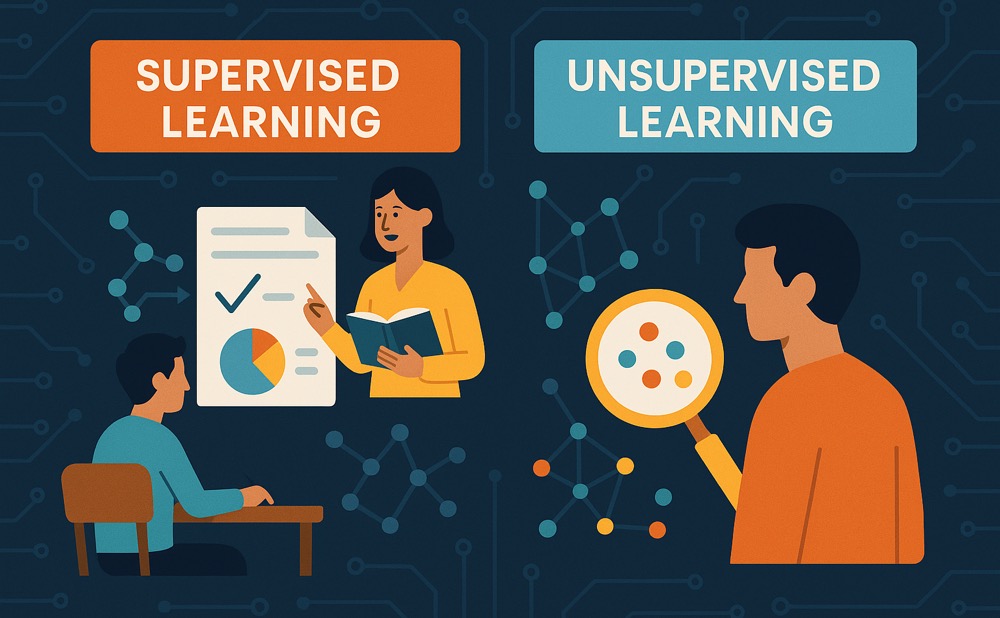Machine learning is transforming industries, enabling smarter products and more efficient operations.
But not all machine learning works the same way.
There are two primary types of learning: supervised and unsupervised learning.
Supervised learning relies on labeled data. It learns from past examples where the correct answers are already known. Think of it as a student who studies with an answer key, seeing the input and output pairs helps them recognize patterns.
Unsupervised learning does not use labeled data. Instead, it finds patterns and relationships in data on its own. It’s like a detective piecing together clues without knowing the solution beforehand.
Or, think of it another way. Imagine you’re learning a new language. There are two ways to do it:
- With a teacher – You get a tutor who teaches you vocabulary, corrects your mistakes, and provides translations. Over time, you get better by practicing with guidance.
- By immersion – You move to a foreign country with no formal instruction. You pick up patterns, recognize common phrases, and slowly figure out meanings based on context, but there’s no one confirming if you’re right or wrong.
Supervised learning is like the structured class, while unsupervised learning is the immersive self-discovery process.
Both approaches power AI features in products, but they serve different purposes. Supervised learning is great for predictions and classifications, while unsupervised learning is best for discovering hidden insights and clustering data into meaningful groups.
Impact on Product Development
The machine learning approach you choose doesn’t just affect your technology stack, it can shape product development and the entire business operation.
For product leaders, understanding the trade-offs between supervised and unsupervised learning is critical. These methods influence everything from how features are designed to how value is delivered to customers, how data is collected and structured, and even how costs scale over time which affects long term business growth and overall profitability.
Below are a few key areas where this choice plays out most clearly in the real-world.
1. Fraud Detection
For banks and other financial services firms, supervised learning can help to identify known types of fraudulent transactions based on past data. On the other hand, unsupervised learning can aid in detecting anomalies that don’t fit normal patterns, uncovering types of fraud that would have previously gone undiscovered.
JPMorgan uses machine learning to screen billions of transactions daily, helping it to reduce false positives by over 50% compared to traditional rules-based systems. This not only lowers fraud losses and operational costs, but also improves the customer experience by reducing unnecessary blocking of transactions.
2. Advisory Services
For OpenAI and other firms creating AI-powered chatbots, supervised learning can be used to train chatbots with labeled conversations, ensuring that these systems respond safely and accurately. This is likely to be increasingly relevant and important for professional services firms, in sectors like law, finance, and management consulting. Firms that embrace these AI tools stand to benefit by being able to provide advisory services to more clients with fewer professional staff, thereby increasing sales and profitability. Any firms that fail to adopt these new tools are likely to become increasingly uncompetitive over time.
3. Personalized Recommendations
For firms like Amazon, Netflix and other online retailers, supervised learning can be used to create personalized recommendations.
But the real magic comes from unsupervised learning, which can be used to group users into segments without the need for predefined categories. Instead of manually defining customer segments, unsupervised learning can analyze the purchasing or viewing behavior of large numbers of customers and automatically cluster customers into meaningful groups based on discovered patterns.
Automated customer segmentation can enable firms to dynamically tailor product offerings, pricing, and marketing strategies in real-time, boosting engagement and conversion rates. For example, Netflix reported that its recommendation system, driven by machine learning, influences over 80% of the content watched on its platform. Similarly, Amazon uses clustering and collaborative filtering to increase average order value and reduce churn by offering targeted suggestions based on the behavioral patterns of large groups of customers. Hyper-personalization has the potential to not only increase customer satisfaction but also drive a significant increase in sales and profitability.
4. Development Costs
Supervised learning requires labeled data, which can be expensive to create. If your product relies on vast amounts of raw data, unsupervised learning may be a more scalable and lower cost option.
This is particularly relevant for early-stage products or data-rich platforms that lack annotated datasets. For instance, on e-commerce or social media platforms, where millions of interactions occur daily, manually labelling data is impractical. Leveraging unsupervised learning enables firms to extract insights – such as emerging consumer trends – without the upfront cost of labelling every piece of data. According to McKinsey, firms using unsupervised or semi-supervised techniques reduce model development time by up to 50%. The shift towards unsupervised learning allows for faster iteration, lower operational costs, and greater flexibility when scaling new software applications.
The bottom line
Both supervised and unsupervised learning have critical roles to play in AI-powered products.
Supervised learning delivers high-accuracy predictions when labeled data is available, while unsupervised learning helps to uncover hidden patterns in raw data.
Product leaders should understand the distinctions between these two approaches to machine learning in order to make informed decisions about AI investments, personalization strategies, and automation features.
Firms that effectively leverage both approaches have the potential to build smarter, more adaptive products that deliver a source of competitive advantage.
Zuhair Imaduddin is a Senior Product Manager at Wells Fargo. He previously worked at JPMorgan Chase and graduated from Cornell University.
Image: DALL-E
🔴 Found these ideas useful?
Sharpen your edge
